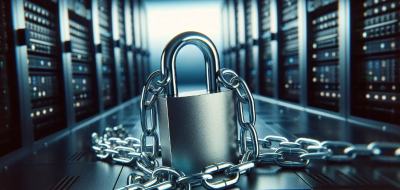Flashpoint's 2022 Annual Review shows that 39 billion records were leaked in just one year. This alarming data has sounded the alarm for people, and enterprises and organizations urgently need to take effective database security measures to defend against such threats.
Database security practices are slightly different from network security practices, which include physical steps, software solutions, and even employee training. In addition, it is also important to protect the organization's website to minimize potential attack vectors and avoid being exploited by hackers.

Flashpoint's 2022 Annual Review shows that 39 billion records were leaked in just one year. This alarming data has sounded the alarm for people, and enterprises and organizations urgently need to take effective database security measures to defend against such threats.
Database security practices are slightly different from network security practices, which include physical steps, software solutions, and even employee training. In addition, it is also important to protect the organization's website to minimize potential attack vectors and avoid being exploited by hackers.

- Deploy physical protection measures for the database
Both the data center and the organization's own servers are inevitably subject to physical attacks, which may come from external threat actors or even internal employees of the organization. However, once criminals gain physical access to the organization's database, they can steal or destroy the data within the organization, and can also gain remote access by injecting malware into the database server.
For organizations that have their own servers, this article strongly recommends taking some physical security measures (such as cameras, security locks, and dedicated security guards) to protect the organization's sensitive data. In addition, all access records in the physical server should also be recorded and submitted and only submitted to the dedicated responsible personnel to reduce the risk of malicious activities. Physical security standards for server rooms include:
• ISO 27001
• ISO 20000-1
• NIST SPs (SP 800-14, SP 800-23, and SP 800-53)
• U.S. Department of Defense Information Assurance Technical Framework
• SSAE 18 SOC 1 Type II, SOC 2 Type II and SOC 3
- Isolate database servers
To protect their databases from cyber attacks, organizations must take targeted security measures. At the same time, in order to reduce the risk of databases being exposed to cyber attack vectors, organizations should also try to avoid placing databases and sites on the same server.
For e-commerce organizations that store sites and sensitive data on the same server, the risk they face is that any attack that invades the website or online business platform may further access their servers. Although the website security measures provided by the hosting service and the security features of the e-commerce platform can prevent cyber attacks and fraud to a certain extent, such organizations still find it difficult to avoid attacks from the Internet or online trading platforms.
To mitigate such security risks, organizations need to separate database servers from all other servers. In addition, organizations can also choose to use real-time security information and event monitoring (SIEM) to reduce the risk of network attacks. SIEM is a security solution for databases that aims to help organizations take action to defend against threats as soon as they are attacked. In addition, vulnerability management solutions are also an option worth considering, which can accurately and effectively assess the security risks faced by network assets.
- Set up an HTTPS proxy server
Before accessing the database server, the proxy server will evaluate requests from workstations. In a sense, the server acts as a "gatekeeper" to block unauthorized requests.
Common proxy servers are based on the HTTP protocol. But if the organization is dealing with sensitive information (such as passwords, payment information, or personal information), then it is necessary to set up a server based on the HTTPS protocol. In this way, the data passing through the proxy server will also be encrypted, adding a layer of security protection for the organization.
- Avoid using default network ports
When transmitting data between servers, TCP and UDP protocols are used. When setting these protocols, organizations usually automatically use the default network ports.
Since default ports are commonly used, they often become the "frequent visitors" of brute force attacks. Organizations can replace the default ports to force cyber attackers to try different port number changes, thereby increasing their workload and attack time.
It should be noted that when assigning new ports, check the port registry of the Internet Assigned Numbers Authority in advance to ensure that the new port is not used for other services.
- Use real-time database monitoring
Actively scan intrusion behaviors in the database to protect the security of the organization and respond to potential attacks.
To ensure the security of the database, organizations can use monitoring software such as Tripwire's real-time File Integrity Monitoring (FIM) to record all operations in the database and warn of possible vulnerabilities. In addition, when facing potential attacks, organizations can also set up upgrade protocols to protect the security of sensitive data.
In addition, regular security audits of the database and penetration tests for the organization's network security are required. These measures can help organizations discover potential security vulnerabilities and fix them before they are exploited, thereby further ensuring the security of the database.
- Use database and web application firewalls
Firewalls are the first layer of defense against malicious access attempts. In addition to protecting their own sites, organizations also need to install firewalls to protect databases from attacks from different vectors.
Here are three common types of firewalls:
• Packet filter firewall
• Stateful packet inspection (SPI)
• Proxy server firewall
Organizations can effectively cover all security vulnerabilities by configuring firewalls. But in order to ensure that websites and databases are protected from new attacks, it is equally important to update the firewall in real time.
- Deploy data encryption protocols
Data encryption is not only important in protecting trade secrets, but also plays an important role in the transmission and storage of user sensitive data, preventing ransomware, and complying with data privacy laws such as GDPR.
Setting up data encryption protocols can reduce the risk of data leakage. Even if malicious elements steal the organization's data, it is still safe because the data is in an encrypted state. At the same time, this also means that the organization's data is not only safe at rest, but also maintains its security during dynamic transmission.
- Create regular backups of the database
Creating website backups is a common operation, but it is more important to create backups of the database regularly and encrypt the backup copies. This can reduce the risk of sensitive data loss due to malicious attacks or data corruption. It is recommended to use the "321" backup rule:
• Store three copies of data;
• Use two types of storage;
• Store a copy outside the system.
In order to ensure the integrity of the backup and that employees have sufficient expertise and experience, the backups of critical mission infrastructure should be tested regularly so that backup recovery can be completed in a timely manner. "
- Keep applications updated in real time
Studies show that 88% of code bases contain outdated components. These outdated components may have vulnerabilities, which can be exploited by malware to help hackers illegally access other areas of the organization's network. In short, when organizations use software to manage their own databases or websites, some serious security risks will also come with it.
For organizations, only trusted and verified database management software is worth using. At the same time, organizations also need to keep the software updated in real time and install new patches in a timely manner. The same is true for widgets, plug-ins, and third-party applications. If these software cannot provide patches in a timely manner, then organizations should avoid using them as much as possible.
- Use strong user authentication
According to Verizon According to the 2022 Data Breach Investigation Report, 67% of data breaches last year were caused by leaked credentials. Today, single authentication methods are no longer secure, and some even believe that passwords are useless. Therefore, even social media sites should at least adopt two-factor authentication (2FA). As for multi-factor authentication (MFA), it is now widely accepted as the standard for secure user authentication. At the same time, it also plays a key role in obtaining cyber insurance qualifications.
Today, cyber criminals can illegally access cloud resources by bypassing MFA checkpoints. The situation is changing, and a password-free future may soon appear.
To further reduce the risk of potential data breaches, organizations should ensure that only verified IP addresses can access their databases. Although IP addresses can be copied or blocked, attackers need to make extra efforts to bypass this security measure. This can increase the difficulty of attacks to a certain extent.
Enhance database security to reduce the risk of data breaches
Using industry-standard best practices to protect databases can provide more in-depth defense layers for organizations' zero-trust solutions. As the number of intrusion incidents continues to increase, the possibility of threat actors invading organizational networks is also increasing. To improve the resilience of the system, organizations should prepare to back up and encrypt data in advance.
Conclusion:
Database security is a comprehensive and systematic issue, so the best practices involved are also multi-faceted and wide-ranging. As the scope of database technology application continues to expand, database security measures must take a three-dimensional development path. This means that we need to think about and master the best practices of database security in an all-round way, and at the same time, we need to continue to learn and master the latest security technologies and solutions. In the future, database security trends will be more intelligent, automated, cloud-based, and networked, and technologies such as data classification storage, intelligent encryption, and cloud-native security will be widely used. In addition, the realization of database security not only depends on the application of technical means, but also requires the joint action of laws, regulations, management, and social factors.


